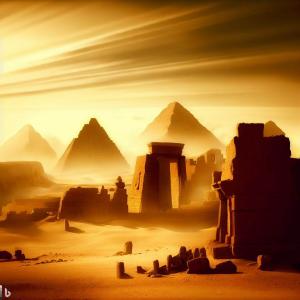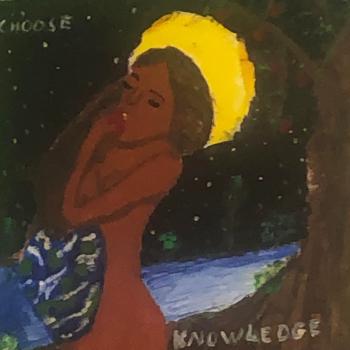
Today we take a break from the Women in the Bible Series to hear from a guest blogger, Joseph DeWayne Parks RN, BSN. Joseph and I attended college Religion courses together. He is an expert in Religious History. In this article, Joseph will introduce us to the history of Ancient Egypt. The Women in The Bible Series will continue next week so please stay tuned.
July 27, 2023
Pyramids, mummies, hieroglyphs, the Nile River, a pantheon of powerful deities, and dynasties of mighty pharaohs. These are several things that come to mind when most people think of ancient Egypt – one of the greatest and most influential civilizations to have developed in human history. In this series of research articles, I will be discussing the role the Egyptian civilization played in the formation of the Jewish faith and its sacred texts. I will also explore in detail the historicity of the biblical stories set in ancient Egypt and how elements of Egyptian culture, language, and worldview can be found within the pages of the Bible.
Ancient Egypt’s Development
The first Egyptians were hunter-gathers who established settlements along the fertile banks of the Nile and along the lakes of the Faiyum region 70,000 years ago. Egypt was divided into two kingdoms each ruled by their kings and worshipped their gods – Upper Egypt (which was the southern half of the nation and extended to the cataracts of the Nile that served as the border between Egypt and Nubia) and Lower Egypt (which was the northern half of the nation and extended to the Nile Delta which emptied into the Mediterranean Sea).
The age of the pharaohs began in c. 3150 B.C. when a king of Upper Egypt named Menes conquered Lower Egypt and unified Egypt as a single nation-state. Menes, who also went by the name Narmer according to many Egyptologists, would become Egypt’s first pharaoh and his reign was marked by the founded on the city of Memphis and the expansion of Egyptian territory into Nubia and Canaan.
8 Time Periods of Egypt
Egyptologists divide the history of the Egyptian civilization into eight time periods known as the Old Kingdom (c. 2613 – 2181 B.C.), the First Intermediate Period (c. 2181 – 2040 B.C.), the Middle Kingdom (c. 2040 – 1782 B.C.), the Second Intermediate Period (c. 1782-1570 B.C.), the New Kingdom (c. 1570-1069 B.C,) the Third Intermediate Period (c. 1069-525 B.C.), the Late Period (525-332 B.C.), and the Ptolemaic Period (332-30 B.C.).
The Old, Middle, and New Kingdom periods were the times when Egypt was ruled under a centralized government ruled by native Egyptian pharaohs from succeeding dynasties while the Intermediate Periods were the times when Egypt became politically unstable, the centralized government collapsed, and various groups fought amongst themselves to rule as self-appointed pharaonic dynasties. The Late Period of Egyptian history involved Egypt beginning part of the Persian Empire while the Ptolemaic Period of Egyptian history involved Egypt build ruled by a dynasty of Macedonian Greek pharaohs who took control of Egypt following the death of Alexander the Great. The Egyptian civilization came to an end on August 12, 30 B.C. with the annexation of Egypt by the Roman Empire and the suicide of Egypt’s last pharaoh – Queen Cleopatra VII.
Egyptian Culture
Three things to keep in mind when studying ancient Egypt are the ancient Egyptian religion, the ancient Egyptian socioeconomic system, and ancient Egypt’s worldview. The ancient Egyptians were polytheistic, and each deity controlled many aspects of the natural or supernatural world such as Hathor -the goddess of love, beauty, sex, and joy who was also the protector of miners and foreigners. The ancient Egyptian religion had no canonical scripture and myths varied from not only different periods but also varied from city to city. For example, the Creation Story as told by the priests at Heliopolis claims it was the god Atum who created the universe through self-procreation while the Creation Story as told by the priests at Memphis claims it was the god Ptah who created the universe through speaking.
Many gods also existed as different gods in unique situations such as Ra – the main Sun god – taking the form of the god Khepri to symbolize the Sun at dawn and taking the form of the god Atum to symbolize the Sun at dusk. The afterlife is perhaps the most well-known part of the ancient Egyptian religion and the ancient Egyptians believed that the afterlife was open to all people who passed the Weighting of the Heart – a test conducted by the gods of the heart of the deceased to see if the deceased lived a righteous life by weighting their heart upon a scale.
Social Structure of Ancient Egypt
Regarding ancient Egypt’s social structure, it can be organized – ironically – as a pyramid with the pharaoh at the top. Below the pharaoh were the royal family, members of the royal court, and government officials who ruled on the pharaoh’s behalf like the grand vizier. Below them was the class of Egyptian priests and nobles.
Egypt was divided into 36 provinces known as nomes and each nome was ruled by a governor called a nomarch who had to answer to the pharaoh. The priests were in charge of the temples and held social and political power due to their ability to connect humanity with the gods. It was a common occurrence in ancient Egyptian history to see many pharaohs have to butt heads with factions of power-hungry nomarchs or priests to show them who was the one who bore the crown, and this sometimes led to rebellions and civil wars. The next class consisted of Egypt’s military and scribes.
Government
The ancient Egyptian government could be described as a combination of an absolute monarchy, a theocracy, and a military dictatorship since the army and police force were needed to maintain peace in society and they had no qualms with using brutality to make it so. The scribes were the most important members of Egyptian society since it was these men and women who knew how to read and write in the Egyptian scripts of hieroglyphs, demotic, and hieratic [hieroglyphs were for sacred texts and monumental carvings while demotic and hieratic where used for everyday communication like letters and taxes] and many scribes used their advanced education to climb the social latter to become government agents or specialists such as physicians and engineers. The next class consisted of artisans and merchants and at the bottom of the pyramid were peasant farmers and slaves.
The majority of the Egyptian population were farmers, and little is known about their daily life due to illiteracy and poor documentation. While ancient Egypt allowed slavery, some laws gave slaves limited protections, and slaves also could escape from enslavement and climb up the social ladder if they had wealth, education, and good luck.
Worldview of Ancient Egypt
Finally, the ancient Egyptian worldview is perhaps the most unique aspect of this civilization. The ancient Egyptians believed in a universal concept of truth and justice known as ma’at. Ma’at was also the name of the ancient Egyptian goddess of truth and justice. If ma’at was to not be maintained, then isfet (or chaos) would take over and destroy the natural order of the universe. Ma’at was maintained by ensuring that all Egyptians followed ethical and moral principles in all accepts of daily life. These would include not committing evil deeds, helping those in need, and acting honorably and truthfully in all matters involving the family, the nation, the natural world, and the divine. Wisdom was also highly praised in Egypt and being wise was seen as having both practical knowledge and knowledge on how to live a good life.
Biblical History of Ancient Egypt
Regarding biblical history, the three periods of Egyptian history that appear during the story of the Hebrew Scriptures are the Second Intermediate Period (which serves as the setting for the story of Joseph), the New Kingdom Period (which serves as the setting for the story of Moses and the background for events in the Books of Joshua and Judges), and the Third Intermediate Period (which serves as the background for the times Egypt influenced the Kingdoms of Israel and Judah). Future articles will go over how ancient Egypt was viewed in its literary context of ancient Jewish literature, how historically accurate the biblical stories set in ancient Egypt were, and how the culture and wisdom of ancient Egypt influenced both ancient Israel and the Hebrew Scriptures.
Please stay tuned for the continuation of The Women in The Bible series next week. Click here and subscribe to the newsletter to be alerted when new articles are published.
















